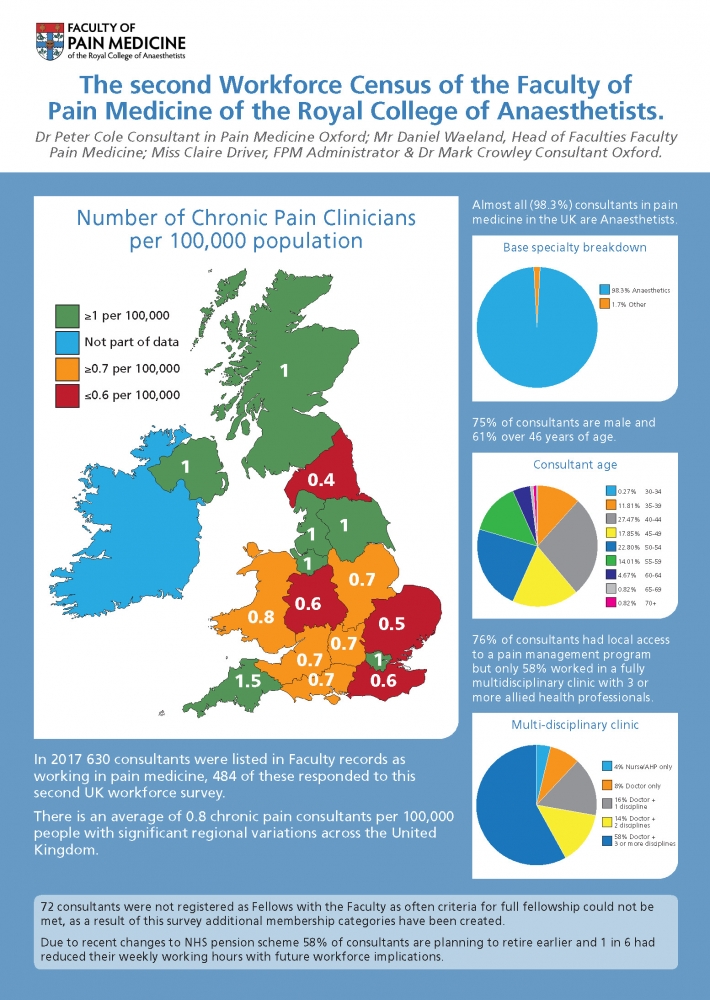Previous Census Data
What is the current Pain Medicine Specialist workforce?
- The number of Pain Medicine consultants and Staff and Associate Specialist doctors is estimated to be circa 615, with circa 30 doctors annual training in Pain Medicine. As many consultants undertake only Acute/Inpatient Pain sessions, the number of consultants may be closer to 500 still active in chronic pain
- Pain Medicine is historically under resourced. The population of the UK is 66.85m (2019), meaning there is one Pain Medicine consultant per 109k of the population. This compares to one Pain Medicine consultant per 77k of the population across Australia and New Zealand
- There is national variation, with an average of 1 doctor per 100k of the population in Scotland, but over the border in the North of England, there is 0.4 doctors per 100k of the population
- 98% of Pain Medicine doctors are from an Anaesthetic background
- The average (mean) number of pain Direct Clinical Care Programmed Activities (DCC-PAs) worked was 4.24 per week across an average of 8 total DCC-PAs. This means the workforce works on average half of their time in Pain Medicine and half in another specialty
- 61% of the workforce are aged over 46 years of age (up from 56% in 2015), indicating an aging workforce
- 25% of the workforce are female. This is up from 22% in 2015 but lower than the number of women in Anaesthetics (32%). However, it is a specialist area that female Pain Medicine doctors note as being supportive and collaborative.
What challenges are currently facing Pain Medicine services?
- An ageing population brings with it increased incidence of musculoskeletal and spinal pain, cancer pain, diabetes and associated painful morbidities, postsurgical pain from complex surgical procedures, visceral pain and ischaemic heart disease
- However, the number of consultant post advertised annually remains broadly the same (see Advisory Appointment Committee data below)
- Longer waits for treatments lead to poorer outcomes (Gwilym et al, Arthritis & Rheumatism 2009), but it can often take years to reach specialist services
- Unfortunately, a siloed approach to commissioning has led to decommissioning of some important specialist services. We fear, without our intervention, that there would have been even more essential services lost.
What are Pain Medicine Services and why do we need them?
Pain Medicine Specialists have the training and experience to manage multiprofessional Specialist Pain Medicine Services. These are able to:
- Assess and diagnose patients with an integrated biopsychosocial approach that takes into consideration issues such as mental wellbeing
- Ensure patients remain under review
- Give the assessment time to investigate and explain conditions and their management, and to take part in shared decision making with empowered patients
- Rationalise treatments, including optimizing the use of medicines and referrals to both offer patients the most effective pathway and to ensure the cost effective use of resources
- Offer specialist treatments and complex case management for high frequency healthcare users
- Collaborative work across different sectors and parts of the hospital.
What is the Faculty doing in this area?
- The Faculty is working with the General Medical Council to develop a Credential in Pain Medicine, which will potentially open up training to more doctors, helping to create a more sustainable workforce
- The Faculty has successfully put forward a case with NHS Improvement for a special advisor to the Getting It Right First Time to do a full review across England of Specialist Pain Services, which may help demonstrate the benefits of these services and then need to ensure they are protected and flourish
- The Faculty works with the Policy team of the Royal College of Anaesthetists to ensure our workforce messages reach key national stakeholders
- The Faculty will continue to monitor workforce trends on an annual basis through future censuses
- The Faculty has developed standards and guidance that allows commissioners to make informed decisions on commissioning, better preserving effective pain services.

This infographic provides a visual representation of the results of our Workforce Census
